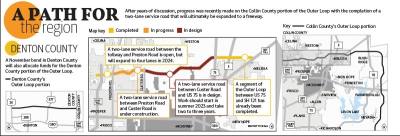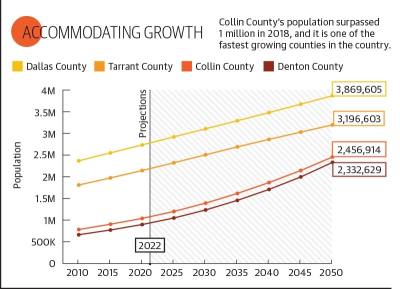In 2023 work is slated to start on a two-lane, east-west frontage road between Preston Road and US 75. It is a segment of the county’s portion of the Outer Loop, a 50-year total proposed freeway project that would extend east from the Denton County and Collin County line then south to Rockwall County once complete.
Collin County’s portion will feed into the larger proposed Outer Loop project—a project that in its entirety will not be finished for several more decades, but would span seven counties and 240 miles around the northern portion of Dallas-Fort Worth, officials said.
“The goal is mobility and to try to alleviate some of the congestion that is going to occur as Collin County continues to develop and grow,” said Duncan Webb, the regional Transportation Council Chair and Collin County Precinct 4 commissioner.
The county is sitting at a population of about 1.1 million people, and it is projected to grow to between 2.5 million and 3.5 million by 2050, Webb said.
Earlier this year, crews completed work on a connecting segment of the frontage road and a portion of the Collin County Outer Loop main lanes between the Dallas North Tollway and Preston Road in the Celina area. When the two-lane service road between the tollway and Preston opened this spring, it immediately became congested, Webb said.
With that road already at capacity, the county is now working to build an additional lane in each direction for that service road, so it will have two lanes moving in each direction. Construction is expected to begin in 2024, but the duration of the construction has not been determined, Webb said.
McKinney Mayor George Fuller said he is excited about progress on the Outer Loop and how it will benefit McKinney residents.
“[The Outer Loop] will provide regional mobility in an area that will continue to grow fast over the next 20 years,” Fuller said.
Paving the way
Since 2000, Collin County has been in the process of planning for the Collin County Outer Loop, starting with a corridor study and leading up to identifying a preferred alignment for the freeway, according to the county’s website.
The freeway is being built in a phased approach, with the service roads constructed ahead of the freeway main lanes and the center of the roadway reserved for a potential rail corridor. The loop already has a two-lane service road that runs between SH 121 and US 75 in Melissa, just north of McKinney.
Mobility plans going back to 2002 and updated in 2007 and 2014 helped refine the proposed regional roadway and its alignment to accommodate the needs of anticipated growth, Webb said.
In 2018, Collin County taxpayers approved a $750 million bond issue, with $600 million reserved strictly for the design, planning and construction of a freeway system in the county. That included building the Outer Loop out from the Collin County and Denton County line to US 75, crossing through the cities of Celina, Prosper and Weston as well as the northern portion of McKinney.
Collin County is using the 2018 bond funds, so the Texas Department of Transportation is not involved. That helps the process go faster, Webb said.
“TxDOT [uses] federal money, and then you have a more complicated procedure for environmental clearance,” Webb said.
Ultimately, the county will have to use TxDOT funds to build the main lanes of the freeway and to assist with clearances needed to build the main lanes. At that point, however, all the service roads should be in place, Webb said.
A major hurdle to cross has been funding the Collin County Outer Loop, which the bond helped with, Webb said. But freeway projects like this take time.
Between the initial planning phase, environmental clearance processes, right-of-way acquisition, moving utilities and finally constructing the road, freeway projects can take about two decades from start to finish, and that is if things go perfectly, he said.
One other factor complicating roadway construction is ongoing development happening throughout the county. Officials have to reroute future roadways if something is built too close to the proposed alignment, Webb said.
“Those plans have had to be tweaked and tweaked and tweaked because the developers keep building, building, building,” he said.
A pathway to progress
There is local demand for east-west connections in Collin County, especially on the western side, such as in McKinney, Webb said.
“In that area is Celina and Prosper, and those two cities are growing like weeds, ... and then you’ve got a lot of development going to the east,” he said.
The upcoming road that will connect Preston to US 75 will “open up a huge area of Northern Collin County,” Webb said.“That’ll be a way for people who are coming from that area who don’t want to use the Dallas North Tollway or Preston; they can go all the way over to [US] 75 and then north or south,” he said.
To increase the regional connection of the Outer Loop, the freeway will also connect from the Collin County/Denton County line and extend west to I-35 in Denton. Denton County commissioners are planning to allocate $30 million of a Nov. 8 bond election to the project.
Like Collin County, Denton County is experiencing rapid growth, with 82 people a day moving in, Denton County’s Transportation Consultant John Polster said. Regional connections
Additional major roadways are in the works to help address the growth in Collin County. TxDOT is working on a potential bypass freeway for US 380, which will arc north of US 380 and south of the Outer Loop, although an exact route is still being determined.
Earlier this year, McKinney City Council passed a resolution that favored an alignment for the bypass that travels into the city of Prosper. However, Prosper officials favor a different alignment that travels into McKinney. Meanwhile, Collin County commissioners passed a resolution saying the existing alignment for US 380 in its current configuration is best. TxDOT is scheduled to identify a preferred US 380 bypass alternative and further develop its schematic design by the end of the year. This will be presented at a public hearing in early 2023.
Whatever form relief comes in for US 380 is welcome, Fuller said.
“We have struggled as a region with [US] 380 and the deficiency of [US] 380. We are getting ahead with the Outer Loop for that high-growth area, which is obviously very beneficial,” Fuller said.
The Outer Loop and the much-discussed US 380 bypass are two projects that will complement each other, Webb said.“The Outer Loop is going to be the midpoint between [US] 380 and the county line,” he said. “There is going to be significant distance between the two. What we were trying to do ... was put in a grid system for freeways.”
To that extent, Collin County commissioners are in the process of a corridor study examining where to place another north-south freeway east of US 75 and connected to the Outer Loop, which would put it through McKinney. The goal is to provide some additional regional connectivity, Webb said.
“Although that area is building out so rapidly, it’s going to be a challenge to find another corridor to put a freeway somewhere between [US] 75 and the Outer Loop on the east side of the county,” he said.








